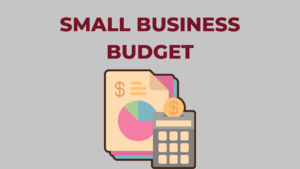
Business owners often struggle to figure out how to best manage their resources and make their businesses more profitable. But, that does not mean you should not try to budget. Instead of struggling with how to budget for your small business, you can use a budget template. Important company choices like reducing unnecessary spending, hiring more people, or investing in new equipment may all be influenced by a budget. If you run out of money, the budget might help you decide how to prioritize your expenditures or change your company strategy. Besides, there are many other uses of an effective and in-depth budget.
We will teach you how to create a budget for your small business and provide you with a free template to help you get srarted. Keep reading!
What is a Business Budget?
An expenditure plan for your company based on your revenue and costs is called a business budget. It determines your available cash, calculates your expenses, and aids in income forecasting.
A budget may aid in the planning of your business operations and serve as a benchmark for the establishment of financial objectives. You may use it to overcome both immediate problems and long-term plans.
What is the IMPORTANCE of a Small Business Budget?
Here are a few reasons as to why Business Budget Planning is important for your success.
• Investors require proof that a firm is properly allocating its funds. A well-structured budget demonstrates organization and dedication to the company. Investors may feel more confident in their decision to invest if they can examine budget sheets and understand how much cash the firm expects to earn in and what its costs are, for which they might use DDQ response software to streamline due diligence questionnaires.

• The utility of the budget is to take into account some costs that come with having a sales force or sales procedures. You might also add how much revenue you anticipate the company will bring in over a specific period of time. With these things in place, you may define sales targets that complement the spending plan and make adjustments as necessary in the future.
• Every business need to have financial objectives that, if met, would indicate that it had a successful year and could carry on with regular business operations or even expand as necessary. Without a budget in place, a company could not be aware of how operations are going and instead learn that it lost money at the end of the year. Because there is a clearer understanding of where the money is coming in and going out, a budget may help a firm and its stakeholders stay on pace to fulfill their goals.
• The majority of firms will have to make important choices that will affect the flow of money into and out of the business. With a budget, you’ll probably find it simpler to make important choices like how much you can afford to raise compensation, if team members can receive bonuses, what perks you can provide staff, or whether there’s room to expand operations.
How to create a Business Budget?(+Free Business Budget Template)
1. Revenue.
Finding all of your revenue or income sources by looking back at your current firm is the first step in any budgeting activity. Find out how much money enters your firm each month by adding up all those sources of income. You can use a spreadsheet to do so.
Verify that you compute for revenue rather than profit when determining your income. All of the money that enters the business up front before expenditures are subtracted becomes your revenue. What’s left over after expenditures are subtracted is the profit.
Calculate your monthly cash flow once you’ve listed all of your sources of income. It’s crucial to carry out this analysis over a number of months, ideally for at least the prior 12 months.
2. Fixed Expenses.
The totaling of all of your fixed expenses is the second stage in establishing a company budget. Any expense required on a recurrent basis for the running of your firm is referred to as a fixed cost. The frequency of fixed expenditures might range from daily to weekly to monthly or even annual, so gather as much information as you can. Fixing your expenses will remove the possibility of unforeseen or unexpected costs. To make this process more efficient and accurate, businesses often rely on spend management tools, which help track, categorize, and control expenses while providing insights for better financial planning.
Some of your fixed expenses may include taxes, rent, insurance, debt and so on.
3. Emergency Funds
Whether or not you’ve ever owned a business, we all understand that variable costs seldom appear at a convenient moment. The refrigerator breaks down the day before you entertain your entire family for Thanksgiving. Your automobile stalls as you’re heading to your greatest presentation of your career.

These expenses frequently occur when money is tight and come up when you least expect them. When planning your business’s budget, make sure you have some extra cash on hand and account for eventualities. This will help you overcome your fear of unforeseen charges.
4. Profit and Loss.
When you’ve gathered all of the aforementioned data, it’s time to compile it into your profit and loss statement.
Additionally, you must add and subtract: total up all of your monthly earnings and outgoing costs. After that, deduct the costs from the revenue, hoping to end up with a positive result.
5. Create an Outline for your Budget.
Projecting what will happen to your firm in the future, whether you’re a startup or have been in business for some time, is informed speculation. Your company experience will undoubtedly improve the accuracy of your estimates.
It’s time to build your budget now that your profit and loss, a historical record of your company’s past, has been prepared. And this paper is future-oriented and forward-looking.
You may better grasp the seasonal ups and downs of your company, the investments that have paid off, and the ones you should steer clear of moving forward by consulting your profit and loss for this phase.
As I had mentioned before, here’s a sample template to help you budget according to your needs.
So, that was all for now. We hope this article was helpful to you. Please don’t forget to leave a comment as we highly appreciate our readers’ feedback.
All the best!